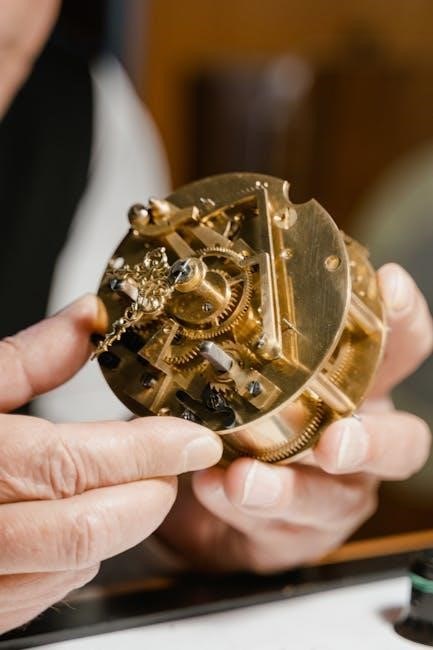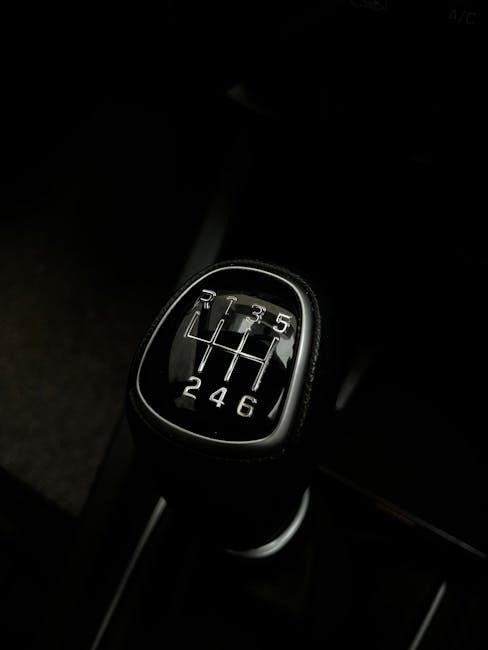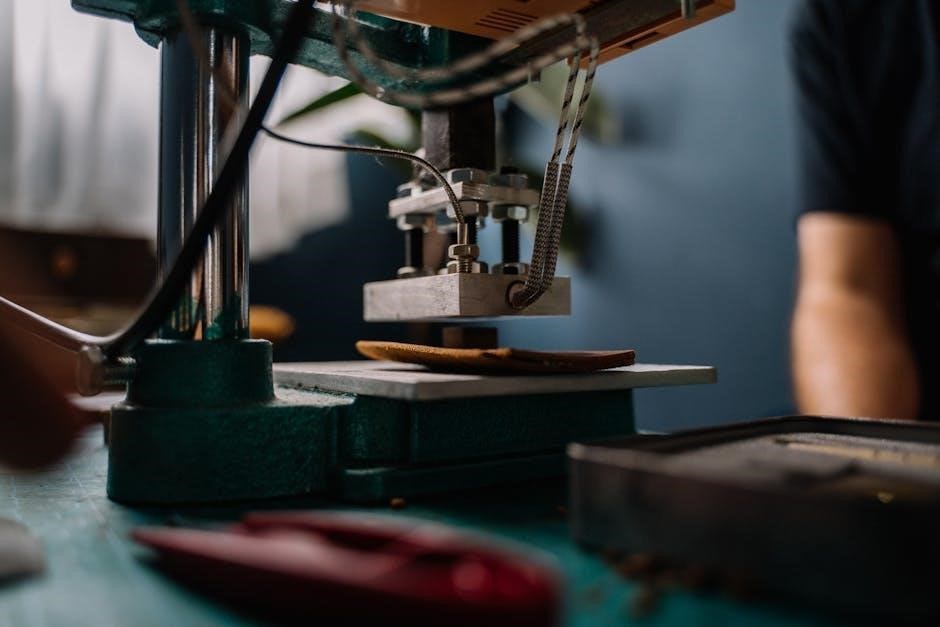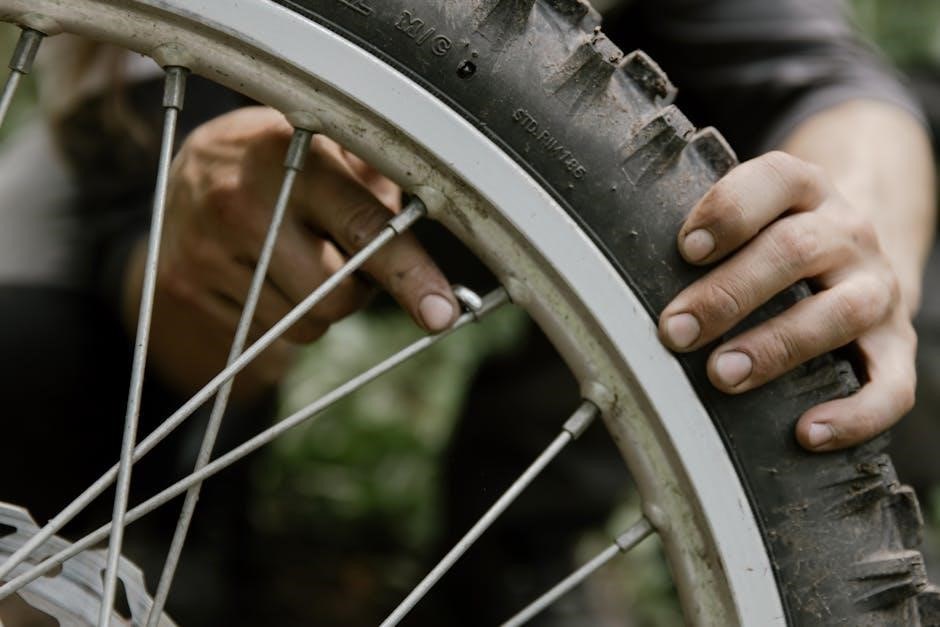Manual transmissions, while durable, can develop issues like gears popping out, often due to worn components or low fluid levels. Ignoring these symptoms can lead to costly repairs and safety risks, making early intervention crucial for maintaining smooth operation and driver safety.
1.1 Overview of Manual Transmissions

Manual transmissions are complex systems designed to transfer power from the engine to the wheels through a series of gears. They rely on driver input to shift gears manually, using a clutch pedal and gearshift. Key components include gears, synchronizers, shift forks, and transmission fluid, which work together to ensure smooth operation. Over time, however, wear and tear can lead to issues like gears popping out of place, a common problem that disrupts driving safety and performance. This overview highlights the fundamental mechanics of manual transmissions and sets the stage for understanding why gears may disengage unexpectedly. Proper maintenance and timely repairs are essential to prevent such issues from escalating into costly failures.
1.2 Importance of Addressing Gear Issues
Addressing gear issues in manual transmissions is critical to ensure both safety and performance. Ignoring symptoms like gears popping out can lead to severe consequences, including sudden loss of control while driving and costly repairs. A 2023 study revealed that 40% of manual transmission failures result from overlooked early signs, such as slippage or difficulty shifting. These issues can escalate into major problems, such as damaged gears or complete transmission failure, which may require expensive overhauls. Additionally, sudden gear disengagement on highways poses significant safety risks. Prompt action is essential to prevent further damage and maintain reliable vehicle operation. Regular inspections and timely repairs can help avoid these complications, ensuring a safer and more efficient driving experience. Early intervention not only saves money but also extends the lifespan of the transmission.

Common Causes
Common causes of gears popping out include damaged shift forks, clutch malfunctions, and issues with the shift linkage or selector spring, leading to unexpected disengagement and potential accidents.
2.1 Worn Synchronizers
Worn synchronizers are a primary cause of gears popping out in manual transmissions. Synchronizers are responsible for ensuring smooth gear transitions by matching the speed of the gear to the shaft; Over time, these components can wear down, reducing their ability to hold the gear in place. This wear often results in gears disengaging unexpectedly, especially during acceleration or deceleration. Symptoms of worn synchronizers include grinding noises and difficulty shifting into specific gears. If left unaddressed, this issue can lead to further damage, such as gear tooth wear or complete transmission failure. Regular inspections and timely replacements of worn synchronizers are essential to maintain smooth transmission operation and prevent costly repairs.
2.2 Damaged Shift Forks
Damaged shift forks are another common cause of gears popping out in manual transmissions. Shift forks are critical components that engage gears by moving them into position. When these forks become bent, worn, or broken, they fail to align gears properly, leading to unexpected disengagement. This issue often results from aggressive shifting or high-stress driving conditions. Symptoms include gears slipping out during acceleration or deceleration, accompanied by clunking noises. If left unrepaired, damaged shift forks can cause further damage to other transmission components, such as gears and synchronizers. Replacing damaged shift forks is essential to restore proper gear engagement and ensure smooth transmission operation. Regular inspections and avoiding aggressive driving habits can help prevent this issue from arising. Timely repairs are crucial to avoid more extensive and costly transmission overhauls.
2.3 Low Transmission Fluid Levels
Low transmission fluid levels are a common culprit behind gears popping out in manual transmissions. Transmission fluid is essential for maintaining hydraulic pressure, which ensures smooth gear engagement. When fluid levels drop, the pressure required to keep gears engaged is insufficient, leading to unexpected disengagement. This issue is often accompanied by difficulty shifting gears and unusual noises during operation. Driving with low fluid levels can also cause the transmission to overheat, exacerbating damage to internal components. It is crucial to check and refill the transmission fluid regularly, using the recommended type to maintain optimal performance. Neglecting this maintenance can result in costly repairs, as damaged gears or other components may need replacement. Addressing low fluid levels promptly is vital to prevent further complications and ensure reliable transmission function. Regular fluid checks are a simple yet effective way to avoid this issue.
2.4 Broken Gears or Components
Broken gears or components within the transmission are a significant cause of gears popping out. Over time, the constant stress on gears can lead to wear and tear, causing teeth to break or components to fracture. When gears are damaged, they fail to engage properly, resulting in unexpected disengagement during operation. This issue is often accompanied by grinding noises and difficulty shifting gears. If left unaddressed, broken gears can cause further damage to other transmission components, leading to costly repairs. Replacing damaged gears or components is essential to restore proper transmission function. Regular inspections and maintenance can help identify and address gear damage early, preventing more severe issues from developing. Addressing broken gears promptly is crucial to ensure smooth transmission performance and avoid potential safety hazards while driving.
2.5 Clutch Issues

Clutch problems are a common contributor to manual transmissions popping out of gear. If the clutch fails to engage or disengage properly, it can disrupt the connection between the engine and the transmission, leading to unexpected gear disengagement; Worn clutch plates, misaligned components, or low hydraulic fluid levels are frequent causes of clutch-related issues. When the clutch doesn’t function correctly, gears may grind or fail to shift smoothly, increasing the likelihood of the transmission slipping out of gear. This issue often manifests as difficulty engaging higher gears or the transmission disengaging during acceleration. Addressing clutch problems promptly is essential to prevent further damage to the transmission system. Regular inspections of the clutch and hydraulic system can help identify and resolve issues before they escalate, ensuring smooth and reliable gear engagement. Proper clutch maintenance is vital for maintaining optimal transmission performance and driver safety.

Symptoms
Common symptoms include gears popping out unexpectedly, difficulty shifting, unusual noises during shifting, and vibrations. These issues can occur during acceleration or deceleration, posing safety risks if unaddressed.

3;1 Gears Popping Out Unexpectedly
One of the most noticeable symptoms of a faulty manual transmission is gears popping out unexpectedly. This can occur during acceleration, deceleration, or even while driving at constant speeds. The issue often stems from worn synchronizers, damaged shift forks, or low transmission fluid levels. When gears disengage unintentionally, the vehicle may lurch or lose power, creating a safety hazard, especially on highways. If left unaddressed, this problem can lead to further damage, such as worn gear teeth or complete transmission failure. Drivers may also notice grinding noises or difficulty shifting into specific gears. Regular inspections and prompt repairs are essential to prevent escalating damage and ensure safe vehicle operation. Addressing this issue early can save costs and maintain smooth transmission performance.
3.2 Difficulty Shifting Gears
Difficulty shifting gears is another common symptom of a manual transmission issue. This problem often arises from worn synchronizers, damaged shift forks, or low transmission fluid levels. When synchronizers degrade, they fail to engage gears smoothly, leading to a stiff or unresponsive gearshift. Similarly, damaged shift forks can prevent proper gear alignment, making it hard to shift into the desired gear. Low transmission fluid levels reduce hydraulic pressure, further complicating the shifting process. Drivers may experience grinding noises or resistance when attempting to shift, especially in higher gears. If left unchecked, this issue can escalate, causing increased wear on transmission components and potentially leading to complete gear engagement failure. Regular maintenance, such as checking fluid levels and inspecting gear components, can help prevent such issues from arising. Early detection and repair are essential to ensure smooth and safe vehicle operation.
3.3 Unusual Noises During Shifting
Unusual noises during shifting are a clear indicator of manual transmission problems. Grinding, clunking, or whining sounds often signal worn or damaged components. These noises may result from worn-out synchronizers, damaged shift forks, or improperly aligned gears. When synchronizers degrade, they fail to engage gears smoothly, leading to grinding noises during shifts. Similarly, damaged shift forks can cause clunking sounds as gears struggle to align properly. Whining noises may indicate issues with bearings or other internal components. These sounds can signal impending issues, as they may lead to gears slipping out of place or failing to engage properly. Addressing these noises promptly is crucial to prevent further damage and ensure smooth gear transitions. Regular inspections can help identify and resolve these problems before they escalate, maintaining the transmission’s performance and longevity. Early intervention is key to avoiding costly repairs and ensuring safe vehicle operation.
3.4 Vibrations During Operation
Vibrations during operation are a concerning symptom of manual transmission issues. These vibrations can occur when gears are misaligned or worn, causing uneven engagement. Misaligned or damaged shift forks, as well as worn-out synchronizers, often contribute to this problem. Vibrations may intensify during acceleration or deceleration, especially when shifting between specific gears. This issue can also be linked to low transmission fluid levels, which reduce hydraulic pressure and disrupt smooth gear engagement. If left unaddressed, vibrations can lead to further damage, such as gear tooth wear or complete transmission failure. Regular inspections and prompt repairs are essential to eliminate vibrations and ensure smooth, stable operation. Ignoring this symptom can result in costly repairs and compromised vehicle safety. Addressing the root cause early is crucial for maintaining optimal transmission performance and preventing further complications.

Diagnosis
Diagnosing a manual transmission that pops out of gear involves visual inspections, driving tests, and diagnostic tools to identify worn components or fluid issues, ensuring accurate repair strategies.
4.1 Visual Inspection of Components
A visual inspection is a critical first step in diagnosing issues with a manual transmission that pops out of gear. This process involves examining key components such as gears, synchronizers, and shift forks for signs of wear or damage. Inspect the gear teeth for grinding or chipping, and check synchronizers for alignment issues or excessive wear. The pilot bearing should also be evaluated for proper alignment and function. Additionally, look for fluid leaks or contamination, as low fluid levels can contribute to slipping gears. Ensure the shift linkage is properly aligned and undamaged, as misalignment can disrupt gear engagement. By identifying worn or damaged parts early, you can address the root cause before further damage occurs. This step is essential for pinpointing issues like worn-out components or misaligned parts, ensuring effective repairs.

4.2 Driving Tests to Identify Patterns
Driving tests are essential for identifying patterns when a manual transmission pops out of gear. Start by accelerating gradually to observe if the transmission slips out of gear at specific RPM ranges. Test in various conditions, such as uphill climbs or deceleration, to replicate the issue. Note the gears where slipping occurs, as this can indicate which components are failing. For example, if slipping happens consistently in higher gears, it may point to worn synchronizers or shift forks. Pay attention to unusual noises or vibrations during shifts, as these can provide clues about the underlying cause. Documenting these observations helps in pinpointing whether the issue is consistent or situational, guiding further diagnostic steps and repairs effectively. This hands-on approach complements visual inspections and diagnostic tools, ensuring a comprehensive understanding of the problem.
4.3 Use of Diagnostic Tools
Diagnostic tools are invaluable for pinpointing the root cause of a manual transmission popping out of gear. Scan tools can detect issues with solenoids or sensors, while pressure testers assess hydraulic system integrity. Endoscopic inspections allow visualization of internal components like gears and synchronizers, revealing wear or damage. These tools provide precise data, helping identify problems such as clutch slippage, worn synchronizers, or low fluid pressure. By analyzing the data, technicians can determine whether the issue stems from mechanical failure or fluid-related problems. Regular use of diagnostic equipment ensures early detection of issues, preventing further damage and costly repairs. This systematic approach complements visual inspections and driving tests, offering a comprehensive understanding of the transmission’s condition and guiding targeted repairs.
4.4 Clutch and Gear Analysis
Clutch and gear analysis is a critical step in diagnosing manual transmission issues. The clutch system, including the master and slave cylinders, must be inspected for proper engagement and disengagement. Worn clutch plates or misaligned components can prevent gears from staying engaged, leading to unexpected disengagement. Gears should be examined for worn teeth or damage, as this can cause slippage. Synchronizers, responsible for smooth gear transitions, are also evaluated for wear or failure. By analyzing these components, technicians can identify whether the problem lies in the clutch mechanism or the gears themselves. This detailed examination ensures accurate diagnoses, allowing for targeted repairs. Regular analysis helps prevent minor issues from escalating into major transmission failures, ensuring optimal performance and safety.
Addressing manual transmission issues involves replacing worn gears, synchronizers, and shift forks. Adjusting or replacing the clutch system and refilling transmission fluid can restore proper function; Professional repair is often necessary. Replacing worn gears and synchronizers is a critical step in resolving manual transmission issues. Over time, gears can wear down, causing improper engagement and unexpected disengagement. Synchronizers, which facilitate smooth gear transitions, can also degrade, leading to difficulty in shifting and gears popping out. When these components are damaged, they must be replaced to restore proper transmission function. A qualified technician should perform this repair, as it involves disassembling the transmission and inspecting related parts like shift forks and interlocks. Proper installation ensures smooth shifting and prevents further damage. Regular maintenance can help identify wear early, avoiding costly repairs. Replacing these components promptly is essential to maintain vehicle performance and safety. Shift forks play a vital role in engaging gears within a manual transmission. When they become bent, worn, or damaged, they can fail to align gears properly, leading to unexpected disengagement. This issue often results from aggressive shifting or high-stress driving conditions. Repairing or replacing shift forks requires disassembling the transmission, which is a complex process typically handled by a professional technician. Proper alignment and reinstallation are crucial to ensure smooth gear engagement. If left unaddressed, damaged shift forks can cause further damage to other components, such as gears and synchronizers. Regular inspections and avoiding aggressive driving habits can help prevent such issues. Addressing shift fork problems promptly is essential to restore transmission performance and prevent costly repairs down the line.
The clutch system is integral to smooth gear engagement in a manual transmission. If the clutch fails to engage or disengage properly, it can cause gears to slip or pop out unexpectedly. Common issues include worn clutch plates, misaligned components, or low hydraulic fluid levels. Adjusting the clutch pedal’s free play or replacing worn parts can often resolve these problems. In severe cases, the entire clutch system may need replacement. Proper functioning ensures the engine disconnects from the transmission during shifting, preventing grinding or unexpected disengagement. Regular inspections of the clutch master and slave cylinders, along with hydraulic fluid checks, are essential to maintain optimal performance. Addressing clutch issues promptly helps prevent further damage to the transmission and ensures safe, smooth driving. Professional assistance is recommended for complex repairs to guarantee reliability and longevity. Low transmission fluid levels are a common cause of gears slipping or popping out. Transmission fluid provides the hydraulic pressure needed for smooth gear engagement. If levels drop, gears may struggle to stay in place, leading to unexpected disengagement. Refilling the fluid to the recommended level can often resolve the issue. It’s crucial to use the correct type of fluid specified by the manufacturer to ensure proper system function. Regular fluid checks are essential to prevent such problems. If the fluid is contaminated or degraded, it should be replaced entirely. Refilling is a straightforward solution, but persistent issues may indicate deeper mechanical problems requiring professional attention. Proper fluid maintenance helps restore smooth gear operation and prevents further damage to the transmission system. Always consult the owner’s manual for guidance on fluid type and refill procedures. When manual transmission issues persist despite DIY fixes, professional repair becomes necessary. Costs vary widely depending on the extent of damage. Replacing worn gears or synchronizers can range from $500 to $1,500, while more severe issues like damaged shift forks or broken components may require a full transmission rebuild, costing between $2,000 and $4,000. In extreme cases, replacing the entire transmission can exceed $5,000. Labor costs also add to the total, making early intervention crucial to avoid escalating expenses. It’s important to consult a qualified mechanic for an accurate diagnosis and cost estimate. While the initial expense may seem high, professional repair ensures long-term reliability and safety, preventing further damage and potential breakdowns. Regular maintenance and prompt repairs can help mitigate these costs over time. Addressing issues early is always more cost-effective than waiting for major failures. Regular fluid checks, clutch inspections, and avoiding aggressive shifting are key to preventing manual transmission issues. These practices ensure smooth operation and extend the lifespan of your gearbox. Regular fluid checks are essential for maintaining the health of a manual transmission. Transmission fluid lubricates gears and ensures smooth shifting. Low fluid levels can lead to insufficient hydraulic pressure, causing gears to slip or pop out unexpectedly. It is recommended to check the fluid level at least every 30,000 miles or as specified in the vehicle’s manual. If the fluid is dirty or degraded, it should be replaced immediately. Proper fluid maintenance prevents overheating and wear on internal components, ensuring reliable performance. Always use the type of fluid recommended by the manufacturer to avoid compatibility issues. Regular fluid checks are a simple yet critical step in preventing costly repairs and extending the lifespan of the transmission. Regular clutch inspections are vital for maintaining smooth manual transmission operation. The clutch system plays a critical role in gear engagement, and issues like worn plates or misalignment can lead to gears popping out. Inspect the clutch pedal for proper free play and ensure the master and slave cylinders are functioning correctly. Low brake fluid levels or air in the hydraulic system can also cause clutch malfunction. Look for signs of wear on the clutch disc and pressure plate, as these components can degrade over time. If the clutch fails to engage or disengage properly, it can result in unexpected gear shifts and operational difficulties. Addressing clutch issues early prevents further damage to the transmission system. Regular inspections help identify potential problems before they escalate, ensuring reliable performance and safety on the road. Aggressive shifting can significantly stress manual transmission components, leading to premature wear and issues like gears popping out. Sudden acceleration, rapid gear changes, and riding the clutch can damage shift forks, synchronizers, and gears. To prevent this, drivers should adopt smooth shifting techniques, avoiding abrupt movements. Shifting at high RPMs or under heavy load increases the risk of component failure. Consistent, gentle pressure on the clutch pedal and deliberate gear transitions reduce wear on internal parts. Additionally, avoiding over-revving and ensuring the vehicle is in the correct gear for speed and load can minimize stress on the transmission. By practicing mindful shifting habits, drivers can extend the lifespan of their manual transmission and reduce the likelihood of unexpected gear disengagement, ensuring safer and more reliable vehicle operation. Regular maintenance and inspections further complement these practices to maintain optimal transmission performance. Addressing manual transmission issues promptly is crucial to prevent costly repairs and ensure safety. Regular maintenance and early intervention can mitigate risks, keeping your vehicle running smoothly and reliably. Manual transmissions popping out of gear often stem from worn components like synchronizers or shift forks, low fluid levels, or clutch issues. Symptoms include unexpected disengagement, difficulty shifting, unusual noises, and vibrations. Addressing these problems early is crucial to prevent costly repairs and ensure safety. Regular maintenance, such as fluid checks and clutch inspections, can help identify issues before they escalate. Replacing damaged parts, adjusting the clutch, and refilling transmission fluid are common solutions. Avoiding aggressive shifting and maintaining proper component alignment also play key roles in preventing further damage. By understanding the causes, symptoms, and solutions, drivers can take proactive steps to maintain smooth transmission performance and avoid potential hazards. Early intervention is essential to extend the lifespan of the transmission and ensure reliable vehicle operation. Early intervention is critical when addressing issues like a manual transmission popping out of gear. Ignoring symptoms such as unexpected disengagement or unusual noises can lead to severe damage, resulting in costly repairs or even requiring a full transmission replacement. Prompt action helps prevent minor issues from escalating into major problems, ensuring the longevity and reliability of the vehicle. Regular inspections and timely repairs not only save money but also enhance safety by avoiding sudden gear failures while driving. By addressing problems early, drivers can maintain smooth transmission performance, reduce the risk of accidents, and avoid the financial burden of extensive repairs. Early intervention is a proactive approach that safeguards both the vehicle and the driver, emphasizing the importance of routine maintenance and quick responses to emerging issues.
Solutions
5.1 Replacing Worn Gears and Synchronizers
5.2 Repairing or Replacing Shift Forks
5.3 Adjusting or Replacing the Clutch System
5.4 Refilling Transmission Fluid
5.5 Professional Repair and Cost Implications

Maintenance Tips
6.1 Regular Fluid Checks
6.2 Clutch Inspections
6.3 Avoiding Aggressive Shifting
7.1 Summary of Key Points
7.2 Importance of Early Intervention
